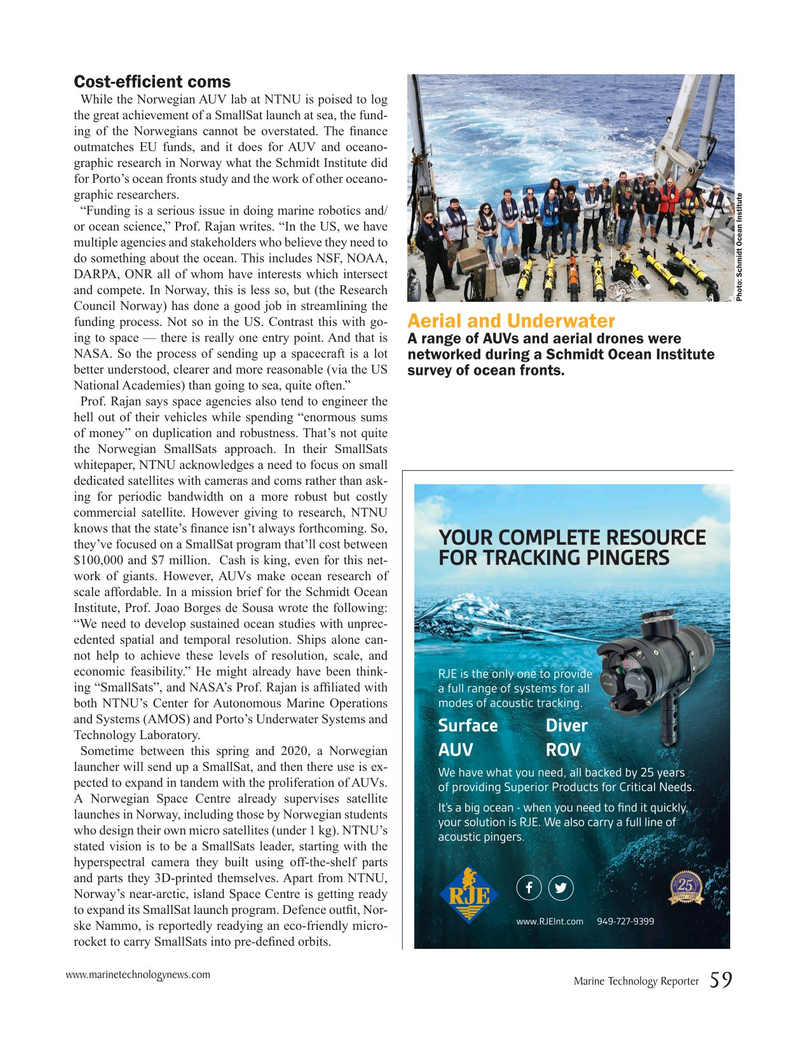
Page 59: of Marine Technology Magazine (March 2019)
Oceanographic Instrumentation: Measurement, Process & Analysis
Read this page in Pdf, Flash or Html5 edition of March 2019 Marine Technology Magazine
Cost-ef? cient coms
While the Norwegian AUV lab at NTNU is poised to log the great achievement of a SmallSat launch at sea, the fund- ing of the Norwegians cannot be overstated. The ? nance outmatches EU funds, and it does for AUV and oceano- graphic research in Norway what the Schmidt Institute did for Porto’s ocean fronts study and the work of other oceano- graphic researchers.
“Funding is a serious issue in doing marine robotics and/ or ocean science,” Prof. Rajan writes. “In the US, we have multiple agencies and stakeholders who believe they need to do something about the ocean. This includes NSF, NOAA,
DARPA, ONR all of whom have interests which intersect and compete. In Norway, this is less so, but (the Research
Photo: Schmidt Ocean Institute
Council Norway) has done a good job in streamlining the funding process. Not so in the US. Contrast this with go-
Aerial and Underwater ing to space — there is really one entry point. And that is
A range of AUVs and aerial drones were
NASA. So the process of sending up a spacecraft is a lot networked during a Schmidt Ocean Institute better understood, clearer and more reasonable (via the US survey of ocean fronts.
National Academies) than going to sea, quite often.”
Prof. Rajan says space agencies also tend to engineer the hell out of their vehicles while spending “enormous sums of money” on duplication and robustness. That’s not quite the Norwegian SmallSats approach. In their SmallSats whitepaper, NTNU acknowledges a need to focus on small dedicated satellites with cameras and coms rather than ask- ing for periodic bandwidth on a more robust but costly commercial satellite. However giving to research, NTNU knows that the state’s ? nance isn’t always forthcoming. So,
YOUR COMPLETE RESOURCE they’ve focused on a SmallSat program that’ll cost between $100,000 and $7 million. Cash is king, even for this net-
FOR TRACKING PINGERS work of giants. However, AUVs make ocean research of scale affordable. In a mission brief for the Schmidt Ocean
Institute, Prof. Joao Borges de Sousa wrote the following: “We need to develop sustained ocean studies with unprec- edented spatial and temporal resolution. Ships alone can- not help to achieve these levels of resolution, scale, and economic feasibility.” He might already have been think-
RJE is the only one to provide ing “SmallSats”, and NASA’s Prof. Rajan is af? liated with a full range of systems for all both NTNU’s Center for Autonomous Marine Operations modes of acoustic tracking. and Systems (AMOS) and Porto’s Underwater Systems and
Surface Diver
Technology Laboratory.
Sometime between this spring and 2020, a Norwegian
AUV ROV launcher will send up a SmallSat, and then there use is ex-
We have what you need, all backed by 25 years pected to expand in tandem with the proliferation of AUVs. of providing Superior Products for Critical Needs.
A Norwegian Space Centre already supervises satellite
It’s a big ocean - when you need to ?nd it quickly, launches in Norway, including those by Norwegian students your solution is RJE. We also carry a full line of who design their own micro satellites (under 1 kg). NTNU’s acoustic pingers.
stated vision is to be a SmallSats leader, starting with the hyperspectral camera they built using off-the-shelf parts and parts they 3D-printed themselves. Apart from NTNU,
Norway’s near-arctic, island Space Centre is getting ready to expand its SmallSat launch program. Defence out? t, Nor- www.RJEInt.com 949-727-9399 ske Nammo, is reportedly readying an eco-friendly micro- rocket to carry SmallSats into pre-de? ned orbits.
www.marinetechnologynews.com
Marine Technology Reporter 59
MTR #2 (50-65).indd 59 3/11/2019 12:25:05 PM

 58
58

 60
60
